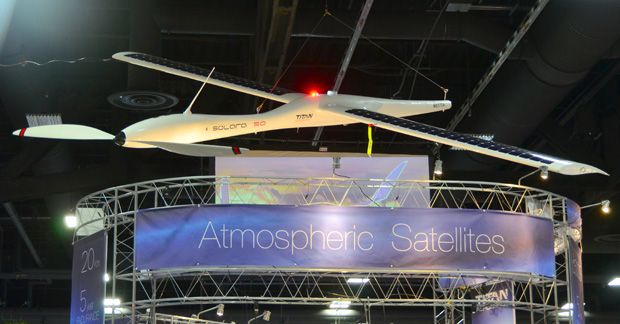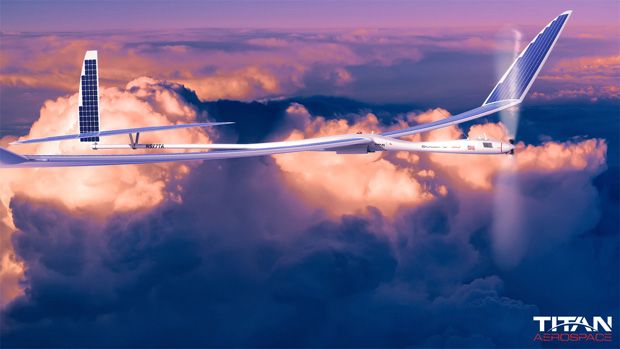- Beranda
- Komunitas
- News
- Militer
AutomatonRoboticsAerial Robots Giant Solar-Powered UAVs Are Atmospheric Satellites
TS
boleroes11
AutomatonRoboticsAerial Robots Giant Solar-Powered UAVs Are Atmospheric Satellites
AutomatonRoboticsAerial Robots
Giant Solar-Powered UAVs Are Atmospheric Satellites
By Evan Ackerman
Posted 21 Aug 2013 | 14:33 GMT

The largest robot in the AUVSI expo hall last week belonged to Titan Aerospace. It was a model of their Solara 50 robotic atmospheric satellite, and they had to chop off the tail and most of the wings to get it to fit. The Solara is intended to lift a payload to 20,000 meters and then keep it there for five years, running entirely on solar power. It functions a bit like a satellite, except substantially cheaper and much more versatile. And, you can get it back when you're done.
It's a little bit hard to tell from the video, but these UAVs are big. The Solara 50 is 15 meters long with a wingspan of 50 meters, and there's an even larger one called the Solara 60, with a 60-meter wingspan. Despite its size, the Solara 50 only weighs 160 kilograms, and it can carry a 30 kg payload, which is fairly respectable.

What makes the Solara actually functional as an atmospheric satellite are two things. The first is the altitude that it's designed to fly at: at 20,000 meters, you're above pretty much everything. You're looking down on clouds and weather, and the winds and temperatures are generally very stable, or at least predictable. Being that high also gives you a field of view encompassing about 45,000 square kilometers. If you were to, say, mount a cellular base station on a Solara, it would take over for a hundred cell towers on the ground.

The second thing that makes Solara work is that it's solar powered. Every available surface on the wings and tail are covered in solar panels, and there are batteries inside the wings. During the day, Solara generates kilowatts of power, and there's enough left over in the batteries to provide hundreds of watts all night. Because the UAV never requires refueling, it can stay aloft for five years, either circling over one spot on the ground, or (if you want it to travel) it's got an effective range of something like 4.5 million kilometers, cruising at just under 60 knots. And that five year life is just based on components, so Solara may very well be able to stay up for longer.
And that leads to the final thing we like about Solara: you can always bring it back down if something goes wrong. Even if nothing goes wrong, you get your payload back at the end of five years, which is usually impossible with satellites. Solara is also much much cheaper than a satellite, although the company isn't quite ready to say how much.

Smaller versions of Solara have already flown, and Titan Aerospace is planning to start selling operational systems in less than a year. This opens up some intriguing possibilities, including things like regional Internet or even a version of something like Google Maps that features real-time imagery. This certainly doesn't mean that the era of the satellite is over, but it means that we'll have a lot more options available than we ever did before.
[ Titan Aerospace ]
============================================
Salah satu penemuan technology baru di bidang UAV, berupa perangkat terbang tanpa awak yg mampu terbang secara nonstop selama lima tahun tanpa henti, dan menggunakan tenaga surya.
"UAV" ini hasil produksi dari TITAN AEROSPACE, di Eropah.
Selain sebagi "UAV , TITAN juga dapat berfungsi sebagai satelit, seperti Satelit LEO (Low Earth Orbit) sehingga memungkinkan dapat memberi informasi / komunikasi secara mangkus pada ketinggian terbang "hanya" 20 Km dpl. serta dapat diakses secara cepat dan real time oleh banyak "BTS", bahkan tidak tertutup kemungkinan dapat bersinergi dengan "UAV" lain yg jamnya terbatas, dalam menyampaikan data visualisasi, komunikasi, dan lainnya yg berkaitan dengan kegiatan misalnya secara real time.
TITAN, kiranya juga dapat dipakai sebagai sarana komunikasi / informasi bagi banyak stakehoulder pemerintah secara real time, baik instasi sipil mau militer tergantung maksud dan tujuan.
Technology TITAN AEROSPACE ini juga sudah di manfaatkan oleh mbah "Google", yg memungkinkan menambah kemampuannya dalam konteks data informasi dan komunikasi nantinya akan lebih cepat dan lebih bagus.
TITAN tentu akan banyak memangkas biaya operasional, serta sangat effisien dan praktis serta mampu memberi kontribusi maksimal dan optimal pada kegiatan banyak hal, terutama di aspek informasi / komunikasi, survaillance dan lainnya.
Giant Solar-Powered UAVs Are Atmospheric Satellites
By Evan Ackerman
Posted 21 Aug 2013 | 14:33 GMT

The largest robot in the AUVSI expo hall last week belonged to Titan Aerospace. It was a model of their Solara 50 robotic atmospheric satellite, and they had to chop off the tail and most of the wings to get it to fit. The Solara is intended to lift a payload to 20,000 meters and then keep it there for five years, running entirely on solar power. It functions a bit like a satellite, except substantially cheaper and much more versatile. And, you can get it back when you're done.
It's a little bit hard to tell from the video, but these UAVs are big. The Solara 50 is 15 meters long with a wingspan of 50 meters, and there's an even larger one called the Solara 60, with a 60-meter wingspan. Despite its size, the Solara 50 only weighs 160 kilograms, and it can carry a 30 kg payload, which is fairly respectable.

What makes the Solara actually functional as an atmospheric satellite are two things. The first is the altitude that it's designed to fly at: at 20,000 meters, you're above pretty much everything. You're looking down on clouds and weather, and the winds and temperatures are generally very stable, or at least predictable. Being that high also gives you a field of view encompassing about 45,000 square kilometers. If you were to, say, mount a cellular base station on a Solara, it would take over for a hundred cell towers on the ground.

The second thing that makes Solara work is that it's solar powered. Every available surface on the wings and tail are covered in solar panels, and there are batteries inside the wings. During the day, Solara generates kilowatts of power, and there's enough left over in the batteries to provide hundreds of watts all night. Because the UAV never requires refueling, it can stay aloft for five years, either circling over one spot on the ground, or (if you want it to travel) it's got an effective range of something like 4.5 million kilometers, cruising at just under 60 knots. And that five year life is just based on components, so Solara may very well be able to stay up for longer.
And that leads to the final thing we like about Solara: you can always bring it back down if something goes wrong. Even if nothing goes wrong, you get your payload back at the end of five years, which is usually impossible with satellites. Solara is also much much cheaper than a satellite, although the company isn't quite ready to say how much.

Smaller versions of Solara have already flown, and Titan Aerospace is planning to start selling operational systems in less than a year. This opens up some intriguing possibilities, including things like regional Internet or even a version of something like Google Maps that features real-time imagery. This certainly doesn't mean that the era of the satellite is over, but it means that we'll have a lot more options available than we ever did before.
[ Titan Aerospace ]
============================================
Salah satu penemuan technology baru di bidang UAV, berupa perangkat terbang tanpa awak yg mampu terbang secara nonstop selama lima tahun tanpa henti, dan menggunakan tenaga surya.
"UAV" ini hasil produksi dari TITAN AEROSPACE, di Eropah.
Selain sebagi "UAV , TITAN juga dapat berfungsi sebagai satelit, seperti Satelit LEO (Low Earth Orbit) sehingga memungkinkan dapat memberi informasi / komunikasi secara mangkus pada ketinggian terbang "hanya" 20 Km dpl. serta dapat diakses secara cepat dan real time oleh banyak "BTS", bahkan tidak tertutup kemungkinan dapat bersinergi dengan "UAV" lain yg jamnya terbatas, dalam menyampaikan data visualisasi, komunikasi, dan lainnya yg berkaitan dengan kegiatan misalnya secara real time.
TITAN, kiranya juga dapat dipakai sebagai sarana komunikasi / informasi bagi banyak stakehoulder pemerintah secara real time, baik instasi sipil mau militer tergantung maksud dan tujuan.
Technology TITAN AEROSPACE ini juga sudah di manfaatkan oleh mbah "Google", yg memungkinkan menambah kemampuannya dalam konteks data informasi dan komunikasi nantinya akan lebih cepat dan lebih bagus.
TITAN tentu akan banyak memangkas biaya operasional, serta sangat effisien dan praktis serta mampu memberi kontribusi maksimal dan optimal pada kegiatan banyak hal, terutama di aspek informasi / komunikasi, survaillance dan lainnya.
0
3.6K
30
Thread Digembok
Urutan
Terbaru
Terlama
Thread Digembok
Komunitas Pilihan